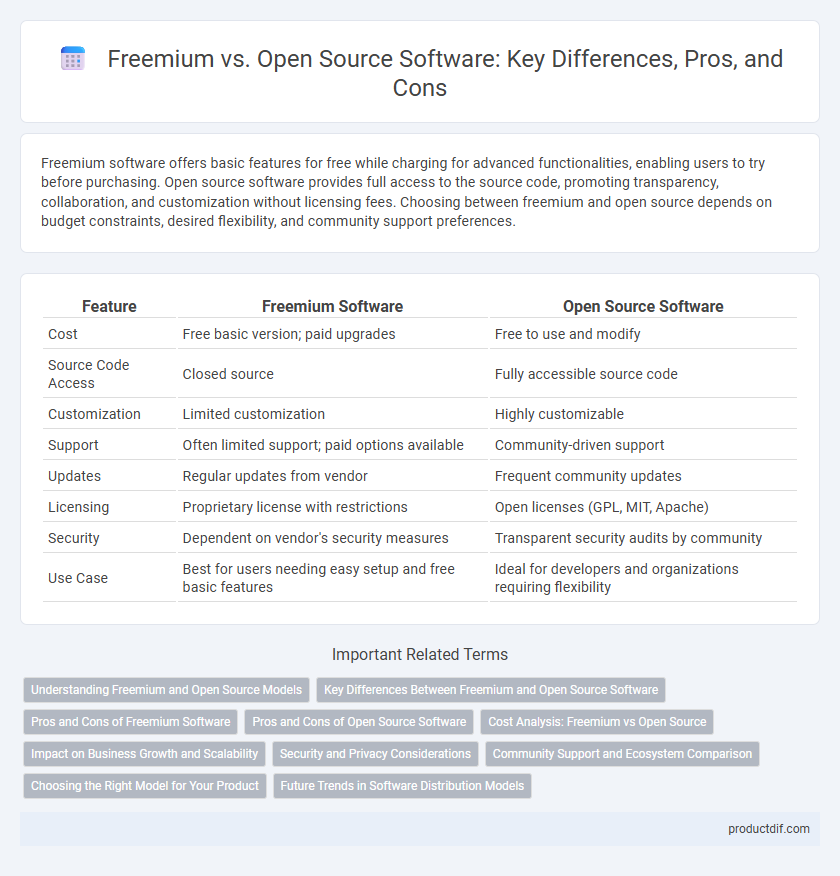Freemium software offers basic features for free while charging for advanced functionalities, enabling users to try before purchasing. Open source software provides full access to the source code, promoting transparency, collaboration, and customization without licensing fees. Choosing between freemium and open source depends on budget constraints, desired flexibility, and community support preferences.
Table of Comparison
| Feature | Freemium Software | Open Source Software |
|---|---|---|
| Cost | Free basic version; paid upgrades | Free to use and modify |
| Source Code Access | Closed source | Fully accessible source code |
| Customization | Limited customization | Highly customizable |
| Support | Often limited support; paid options available | Community-driven support |
| Updates | Regular updates from vendor | Frequent community updates |
| Licensing | Proprietary license with restrictions | Open licenses (GPL, MIT, Apache) |
| Security | Dependent on vendor's security measures | Transparent security audits by community |
| Use Case | Best for users needing easy setup and free basic features | Ideal for developers and organizations requiring flexibility |
Understanding Freemium and Open Source Models
Freemium software offers basic features at no cost while charging for premium functionalities, enabling businesses to monetize a broad user base through upgrades. Open source software provides free access to source code, encouraging collaboration, transparency, and customization among developers. Understanding these models is critical for choosing between proprietary revenue-generating strategies and community-driven development approaches.
Key Differences Between Freemium and Open Source Software
Freemium software offers basic features at no cost with premium upgrades available for purchase, while open source software provides complete access to its source code for free, allowing users to modify and distribute it. Freemium models rely heavily on monetization through subscriptions or in-app purchases, whereas open source projects often depend on community contributions and collaborative development. Licensing is a key distinction: freemium software is proprietary with usage restrictions, whereas open source software is governed by licenses like GPL or MIT that promote transparency and freedom.
Pros and Cons of Freemium Software
Freemium software offers free basic features with optional paid upgrades, enabling wide user adoption and easy market penetration while generating revenue from premium users. However, the limited free version may frustrate users due to feature restrictions, and reliance on premium conversions can hinder long-term sustainability if upgrades are not compelling. Additionally, freemium models risk alienating users who prefer fully open access and transparency typically found in open source alternatives.
Pros and Cons of Open Source Software
Open source software offers significant advantages such as full transparency, enhanced security through community auditing, and the flexibility for users to modify and customize the code to suit their needs. However, it may lack dedicated customer support, potentially leading to longer resolution times, and some projects can suffer from inconsistent updates or fragmented development. Despite these challenges, open source software fosters innovation and collaboration, making it a cost-effective choice for businesses and developers seeking control and adaptability.
Cost Analysis: Freemium vs Open Source
Freemium software offers a low-cost entry point with basic features free, but scaling often requires paid subscriptions, impacting long-term costs. Open source solutions eliminate licensing fees and enable complete customization, but may incur expenses related to implementation, maintenance, and support. Cost analysis should factor in total cost of ownership, including hidden costs like integration, training, and potential vendor lock-in risks in freemium models versus flexibility and community-driven innovation in open source alternatives.
Impact on Business Growth and Scalability
Freemium software models drive rapid user acquisition by offering core features for free while monetizing premium upgrades, enabling scalable revenue growth aligned with market demand. Open source software fosters innovation and lower costs through community collaboration, enhancing scalability but potentially limiting direct monetization and requiring strategic business models for sustainable growth. Balancing freemium's revenue potential with open source's flexible development can optimize long-term business expansion and adaptability.
Security and Privacy Considerations
Freemium software often limits access to source code, creating potential vulnerabilities due to hidden components, whereas open source software enhances security through transparency and community-driven audits. Privacy concerns in freemium models can arise from data monetization strategies embedded in proprietary frameworks, while open source projects typically offer better control over data handling and customization. Security updates in open source software are frequently faster and more reliable, as the collaborative nature allows rapid identification and patching of vulnerabilities.
Community Support and Ecosystem Comparison
Freemium software often benefits from a structured community with dedicated support channels and a growing ecosystem driven by the company's roadmap and user feedback, fostering incremental feature enhancements. Open source projects rely heavily on a diverse, global community of contributors who provide extensive peer-to-peer support, rapid bug fixes, and the ability to customize or extend the software, resulting in a dynamic but less centralized ecosystem. The open source model encourages collaborative innovation and transparency, while freemium platforms offer more predictable updates and official customer service, creating distinct community support and ecosystem dynamics.
Choosing the Right Model for Your Product
Freemium software offers a scalable revenue model by providing basic features for free while charging for premium functionality, making it ideal for products targeting mass-market users with diverse needs. Open source software encourages community collaboration and transparency, accelerating innovation and enabling customization, which suits products prioritizing developer engagement and long-term adaptability. Selecting the right model depends on factors like target audience, monetization strategy, product complexity, and the level of control desired over the software's evolution.
Future Trends in Software Distribution Models
Freemium software models are increasingly integrated with open source components, enabling broader community collaboration while maintaining scalable revenue streams through premium features. Emerging trends highlight hybrid distribution strategies combining open source transparency and freemium monetization to accelerate innovation and user adoption. Artificial intelligence and cloud computing advancements drive new opportunities for personalized, subscription-based software experiences within these evolving models.
Freemium vs Open Source Infographic

 productdif.com
productdif.com